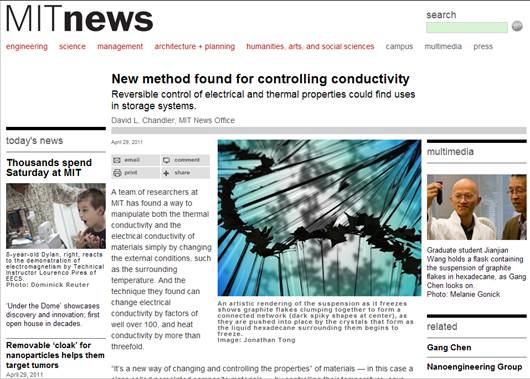博文
新一代室温热敏复合材料(MIT新闻主页)
|||
新一代室温热敏复合材料(MIT News)

近日,麻省理工学院(MIT)在其新闻主页上报道了热敏复合材料方面的研究的一项最新成果。热敏材料的研究已经将近一个世纪,但是迄今为止在室温下具有良好开关特性的热敏材料还没有开发出来。华南师范大学高进伟副教授与北京师范大学郑瑞廷副研究员以及MIT机械系在读博士生王坚坚,MIT机械系陈刚教授(美国工程院院士)合作,开发了一种可以在室温下工作的新型智能热敏复合材料。该成果发表于最新一期的Nature Communication[2]上,并已申请国际专利。
采用具有固定凝固温度的液体与良好传导特性的纳米颗粒合成液相纳米复合材料。环境温度低于液体凝固温度时,该复合材料中的纳米颗粒会被挤压到晶界处,形成具有高导热导电特性的三维逾渗网络。当环境温度上升,液体融化,作用在纳米颗粒上的内压力消失,导致颗粒之间接触阻值增大,复合材料的电导率、热导率迅速下降,从而产生独特的室温热敏特性。此外,通过选择不同的复合材料体系,将会得到具有不同临界热敏温度的复合材料。该材料可以用于线路保护、生物科学研究、环境温度调节、智能建筑以及太阳能应用等其他领域。
对于这项成果,业内专家给予了较高评价。Texas大学Austin分校机械工程系教授Li Shi认为“使用相变控制复合材料的传输特性是一个非常聪明的做法,这是我所知道的这类方法的首次报道”。Ohio 州立大学物理、机械及航空工程系教授Joseph Heremans评价说:“这是一个非常重要的结果,在一个材料体系中可以显著地改变传热特性, 我认为这是一项杰出的工作”。国际知名科技媒体Materials Insight[3]、Esciencenews[4]、Physics News[5]、 Zeitnews[6]、Physorg[7] 均对该报道进行了转载。
MIT 新闻:http://web.mit.edu/newsoffice/2011/switch-conductivity-0429.html
Nature Online : http://www.nature.com/ncomms/journal/v2/n4/full/ncomms1288.html
PhysOrg.com
网站新闻::http://www.physorg.com/news/2011-04-method.html New method found for controlling conductivity Reversible control of electrical and thermal properties could find uses in storage systems.
Image: Jonathan Tong
A team of researchers at MIT has found a way to manipulate both the thermal conductivity and the electrical conductivity of materials simply by changing the external conditions, such as the surrounding temperature. And the technique they found can change electrical conductivity by factors of well over 100, and heat conductivity by more than threefold.
“It’s a new way of changing and controlling the properties” of materials — in this case a class called percolated composite materials — by controlling their temperature, says Gang Chen, MIT’s Carl Richard Soderberg Professor of Power Engineering and director of the Pappalardo Micro and Nano Engineering Laboratories. Chen is the senior author of a paper describing the process that was published online on April 19 and will appear in a forthcoming issue of Nature Communications. The paper’s lead authors are former MIT visiting scholars Ruiting Zheng of Beijing Normal University and Jinwei Gao of South China Normal University, along with current MIT graduate student Jianjian Wang. The research was partly supported by grants from the National Science Foundation.
The system Chen and his colleagues developed could be applied to many different materials for either thermal or electrical applications. The finding is so novel, Chen says, that the researchers hope some of their peers will respond with an immediate, “I have a use for that!”
One potential use of the new system, Chen explains, is for a fuse to protect electronic circuitry. In that application, the material would conduct electricity with little resistance under normal, room-temperature conditions. But if the circuit begins to heat up, that heat would increase the material’s resistance, until at some threshold temperature it essentially blocks the flow, acting like a blown fuse. But then, instead of needing to be reset, as the circuit cools down the resistance decreases and the circuit automatically resumes its function.
Another possible application is for storing heat, such as from a solar thermal collector system, later using it to heat water or homes or to generate electricity. The system’s much-improved thermal conductivity in the solid state helps it transfer heat.
Essentially, what the researchers did was suspend tiny flakes of one material in a liquid that, like water, forms crystals as it solidifies. For their initial experiments, they used flakes of graphite suspended in liquid hexadecane, but they showed the generality of their process by demonstrating the control of conductivity in other combinations of materials as well. The liquid used in this research has a melting point close to room temperature — advantageous for operations near ambient conditions — but the principle should be applicable for high-temperature use as well.
The process works because when the liquid freezes, the pressure of its forming crystal structure pushes the floating particles into closer contact, increasing their electrical and thermal conductance. When it melts, that pressure is relieved and the conductivity goes down. In their experiments, the researchers used a suspension that contained just 0.2 percent graphite flakes by volume. Such suspensions are remarkably stable: Particles remain suspended indefinitely in the liquid, as was shown by examining a container of the mixture three months after mixing.
By selecting different fluids and different materials suspended within that liquid, the critical temperature at which the change takes place can be adjusted at will, Chen says.
“Using phase change to control the conductivity of nanocomposites is a very clever idea,” says Li Shi, a professor of mechanical engineering at the University of Texas at Austin. Shi adds that as far as he knows “this is the first report of this novel approach” to producing such a reversible system.
“I think this is a very crucial result,” says Joseph Heremans, professor of physics and of mechanical and aerospace engineering at Ohio State University. “Heat switches exist,” but involve separate parts made of different materials, whereas “here we have a system with no macroscopic moving parts,” he says. “This is excellent work.”
PHYSORG.COM 评论:http://www.physorg.com/news/2011-04-method.html
https://wap.sciencenet.cn/blog-345574-439032.html
上一篇:王家岭:生命的高地
下一篇:Thermal Percolation in Stable Graphite Suspensions